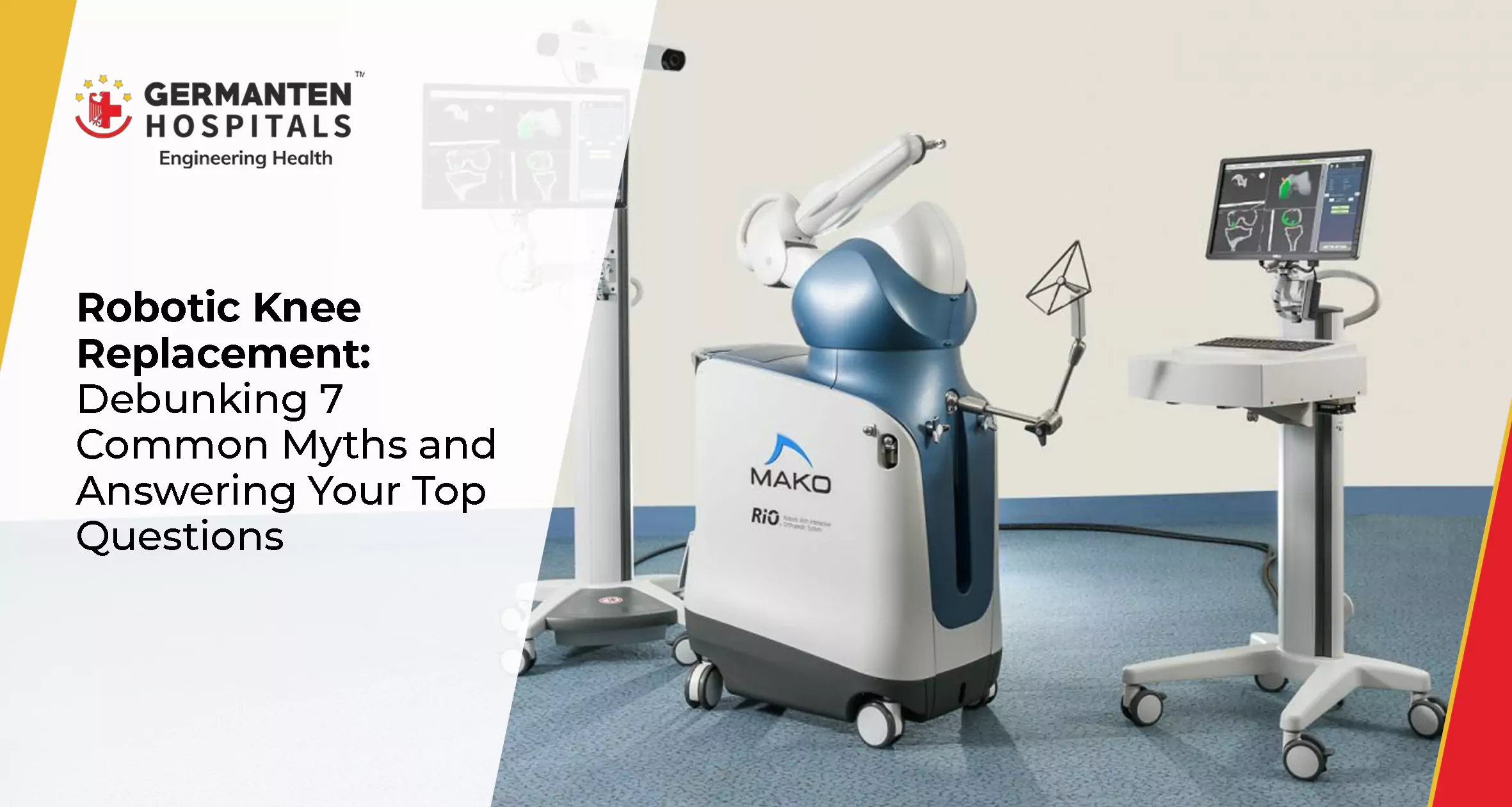The term "robotic surgery" can conjure images from science fiction—a machine operating independently while the surgeon watches from the sidelines. This vision, while futuristic, is far from the reality of modern orthopedic care. At Germanten Hospital, we are proud to be pioneers in Telangana, utilizing advanced German-engineered robotic systems to perform knee replacements with a level of precision that was once unimaginable.
Robotic-assisted knee replacement is a transformative technology, but it's often surrounded by myths and misconceptions. As leaders in this field, we believe in providing clear, factual information to help you understand why this approach is becoming the new gold standard for joint replacement.
Let's debunk seven of the most common myths and answer your most pressing questions about robotic knee replacement surgery.
Myth 1: A Robot Performs the Surgery on Its Own.
The Reality: This is the single most pervasive myth, and it is completely false. The surgeon is, and always will be, in 100% control of the procedure. The robotic system is not autonomous. Instead, it functions as an incredibly sophisticated and precise tool that the surgeon guides.
Think of it like an expert navigator with a high-tech GPS system. Before the journey, a detailed 3D map of your unique knee anatomy is created from a CT scan. This allows the surgeon to create a personalized surgical plan, determining the perfect size, placement, and alignment of your implant before a single incision is made. During the surgery, the robotic arm provides real-time data and sensory feedback, helping the surgeon execute that plan with sub-millimeter accuracy. The robot provides the map and the guidance, but the surgeon is always driving. It enhances the surgeon's skill; it does not replace it.
Myth 2: Robotic Surgery Is Experimental and Riskier Than Traditional Surgery.
The Reality: Robotic-assisted surgery is a well-established and proven technology that has been used successfully in tens of thousands of procedures worldwide. Far from being riskier, it is designed to increase safety and reduce the risks associated with traditional surgery.
The enhanced precision of the robotic arm minimizes the potential for human error in bone cuts and implant positioning. This accuracy helps protect the surrounding healthy soft tissues and ligaments, leading to less trauma during the operation. Numerous studies have shown that this precision can lead to fewer complications, better joint alignment, and a more natural-feeling knee post-surgery.
Myth 3: Recovery Is Longer and More Painful After Robotic Surgery.
The Reality: The opposite is often true. Because robotic surgery allows for a minimally invasive approach with smaller incisions and less damage to the surrounding tissues, many patients experience a significantly faster and less painful recovery.
Here’s a comparison based on clinical observations and patient reports:
- Hospital Stay: Robotic surgery patients often have shorter hospital stays, with many able to go home within 2-3 days.
- Pain Management: Reduced tissue trauma typically means less post-operative pain and a decreased need for strong pain medication.
- Return to Activity: Patients frequently begin walking with support sooner (often within 24-48 hours) and return to light daily activities in 2-4 weeks, compared to the 4-8 week timeline often seen with traditional methods.
Myth 4: Robotic Knee Replacement Is Only for Young or Very Complex Cases.
The Reality: Robotic knee replacement is a versatile technology that offers benefits to a wide range of patients, regardless of age or the complexity of their condition. While it is particularly advantageous for patients with significant knee deformities or unusual anatomy, its benefits of precision and personalization are valuable for everyone.
Whether you are a younger, more active patient seeking a long-lasting implant or an older adult wanting the safest procedure with the quickest recovery, robotic assistance can be tailored to your specific needs. The decision is based on a thorough evaluation by your surgeon to ensure it is the best option for your individual case.
The Research Behind Robotic Precision: Why Accuracy Matters
Recovery is a process that requires patience and commitment, but the results are well worth the effort. The journey begins the moment you leave the operating room.
The primary advantage of robotic-assisted surgery lies in its ability to achieve superior accuracy in implant placement and alignment. Research consistently shows that the long-term success of a knee replacement is heavily dependent on how well the implant is positioned. Even minor misalignments can lead to uneven wear, instability, and the potential need for a future revision surgery.
Robotic systems use 3D virtual modeling to create a surgical plan that is unique to each patient's anatomy. During the procedure, the system provides real-time data that allows the surgeon to adjust for the unique tension of your ligaments, ensuring a perfectly balanced knee. This level of personalization is difficult to achieve with manual instruments alone. Studies have shown that patients who undergo robotic-assisted knee replacement report higher satisfaction rates—as high as 94% compared to 82% in traditional surgery groups—largely due to the more natural feel and better function of the well-aligned joint.
Myth 5: Robotic Surgery Is Too Expensive and Not Covered by Insurance.
The Reality: While the initial investment in robotic technology can make the procedure seem more expensive upfront, it often proves to be more cost-effective in the long run. The enhanced precision leads to fewer complications, lower rates of infection, and a reduced likelihood of needing a costly revision surgery down the road.
Furthermore, because recovery is often faster, patients may have shorter hospital stays and require fewer physical therapy sessions, leading to lower overall healthcare costs. As the benefits of robotic surgery have become well-documented, most major insurance providers now recognize its value and cover the procedure in the same way they cover traditional knee replacement.
Myth 6: The Scars Will Be Bigger and More Noticeable.
The Reality: This is incorrect. Robotic surgery is a form of minimally invasive surgery. The precision of the robotic arm allows the surgeon to work through smaller, more targeted incisions compared to what is often required in traditional open surgery. This results in less scarring, which is not only a cosmetic benefit but also contributes to less tissue trauma and a faster healing process.
Myth 7: The Benefits Aren't Significant Enough to Justify Choosing It.
The Reality: The benefits are substantial and impact every stage of the patient journey.
- For the Patient: A more natural-feeling knee, less pain, a faster return to the activities you love, and the confidence that your implant is positioned for maximum longevity.
- For the Surgeon: The ability to create and execute a highly personalized and precise surgical plan, minimizing variables and enhancing the consistency of excellent outcomes.
At Germanten Hospital, our commitment to "German Precision" is not just a slogan; it's a philosophy embodied by our investment in world-class technologies like robotic surgery.
Frequently Asked Questions
Ready to learn more about how robotic precision can transform your knee replacement experience? Contact Germanten Hospital today to schedule a consultation with our team of robotic surgery experts.



